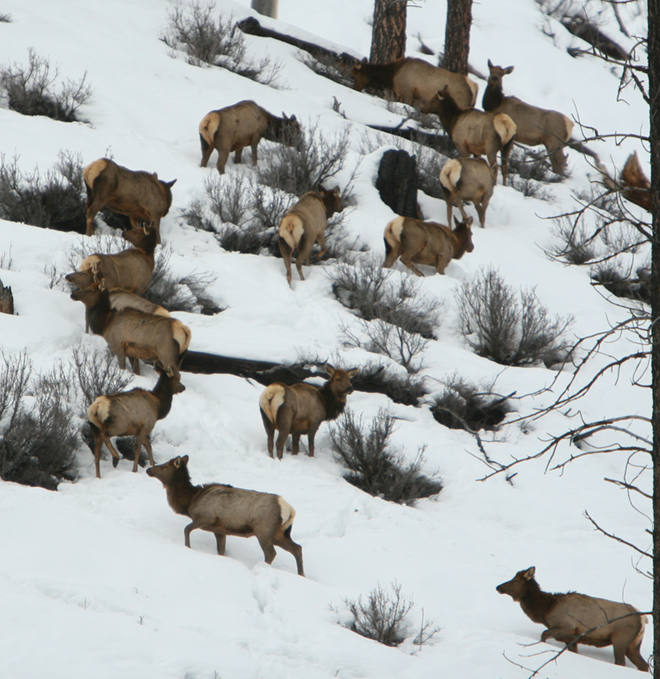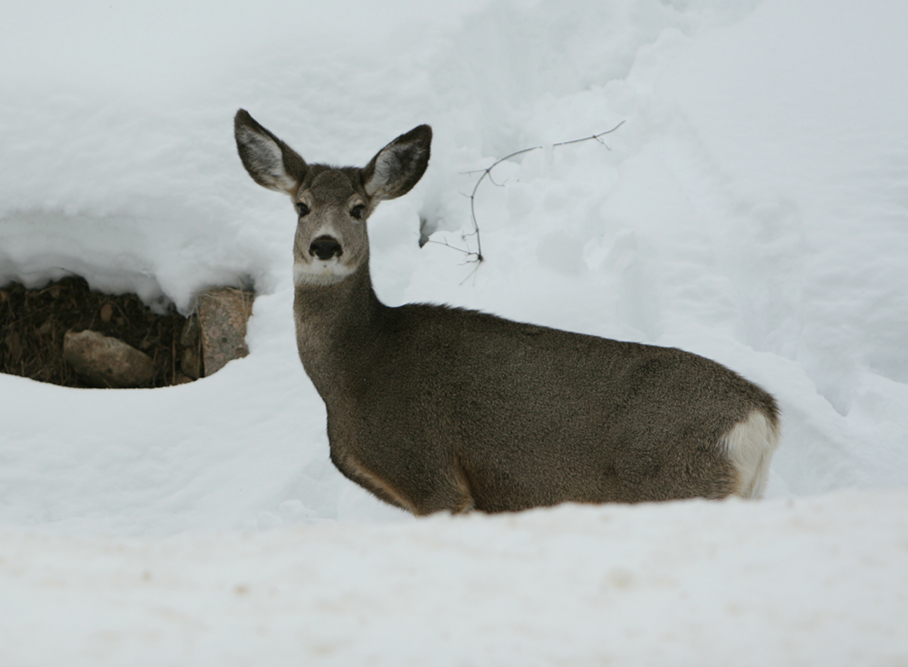The office phone rings more often than usual these days, with citizens calling to voice concern about the welfare of Idaho’s big game animals – specifically mule deer and elk. This year’s more normal Idaho winter, with heavy snowfall and cold temperatures, is compelling animals to move to low elevation winter range where they are noticed by all of us. These winter conditions have some folks convinced that supplemental feeding is necessary to keep big game animals from starving.
Fish and Game wildlife managers and biologists share this concern. Even as winter progresses, we continue to actively monitor the region’s big game herds, and are making necessary preparations should an emergency feeding operation become necessary.
Here’s some winter feeding background information along with the latest update on the region’s big game herds.
Because of their larger size and durability, elk are fed less often than mule deer. Their size allows them to cope with harsh winter conditions much better than their smaller cousins. When elk are provided with winter feed, it’s not normally because they need the nutrition. Rather, feeding is a tool to keep elk from bullying in on deer feed sites. In some cases, feed may also be used strategically to bait elk away from private property where they are causing property damage.

Mule deer are more susceptible to harsh winter conditions, again due to size. With smaller bodies and shorter legs than their cousins, mule deer seek out lower elevation areas sooner than elk to avoid succumbing to winter’s harshness. For these reasons, mule deer are normally the focus when evaluating the need for big game winter feeding efforts.

Over the years, Fish and Game staff have developed a series of guidelines to help us more accurately evaluate the need for winter feeding. It’s not perfect, but is better than a knee-jerk or emotional reaction to the situation. Guidelines for our area include snow depth on south-facing slopes, snow crusting, daytime temperatures and animal body condition.
While the first three criteria are relatively easy to measure, you might wonder how we go about measuring animal body condition. This time of year, we primarily use data collected from big game capture operations to determine overall health of a big game herd. Mule deer fawn weights give us a good idea of potential survival of this year’s fawns (heavier fawns have better survival rates). Body condition of doe mule deer and cow elk is used to predict survival rates for this segment of the big game population.
Fortunately, most of our big game animals appear to have come through the summer and fall months in fine shape. Most have adequate fat reserves and are currently in no need of supplemental feeding. But that could change.
Making Preparations
Two local mule deer herds are being closely monitored by Fish and Game staff. The first herd resides in the Garden Valley/Lowman area, where mule deer were last fed in 2008, when heavy snows blanketed the valley. At present, these deer are in fine shape, and are spending most of their time thermoregulating. This involves moving just enough to stay in the sunshine with minimal foraging. We’ve spotted small groups of deer bedded on south-facing slopes in scattered timber, out of the wind. A premature feeding effort could very well lure them out of these areas to the valley floor creating a host of new problems, including interaction with motorists.
The second area where mule deer potentially face a winter feeding situation is on the Boise River Wildlife Management Area, located in the foothills above Boise. Two large wildfires this summer burned across a large portion of existing mule deer winter range, forcing animals to move further afield to find adequate forage. Yet even with the fires, animals are faring just fine.
A winter feeding effort is not imminent for either herd, but winter conditions can change quickly and we want to be ready should that happen. We have specially-formulated deer and elk pellets on hand in Garden Valley, with additional pellets ordered for delivery to the Boise River Wildlife Management Area. We are working with Boise County officials to plow out historic feed sites in advance of a feeding effort. And we’re mobilizing other equipment – such as feed troughs – and making staff assignments associated with a feeding effort.
We will keep this site updated as winter progresses. Check back to read the latest news.
